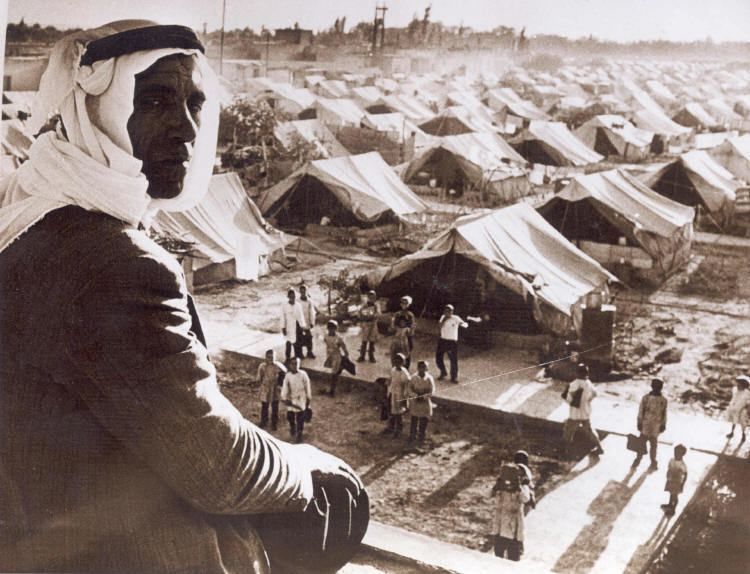Date December 11 1948 Result Adopted | Meeting no. 186 | |
 | ||
Code A/RES/194 (III) (Document) Subject Palestine—Progress Report of the United Nations Mediator Voting summary 35 voted for
15 voted against
8 abstained | ||
United Nations General Assembly Resolution 194 was adopted on December 11, 1948, near the end of the 1948 Arab–Israeli War. The Resolution defined principles for reaching a final settlement and returning Palestine refugees to their homes. It resolved that “refugees wishing to return to their homes and live at peace with their neighbours should be permitted to do so at the earliest practicable date, and that compensation should be paid for the property of those choosing not to return and for loss of or damage to property which, under principles of international law or equity, should be made good by the Governments or authorities responsible.” (Article 11)
Contents
The resolution also called for the establishment of the United Nations Conciliation Commission to facilitate peace between Israel and Arab states, continuing the efforts of UN Mediator Folke Bernadotte, following his assassination.
Of the 58 members of the United Nations at that time, the resolution was adopted by a majority of 35 countries, with 15 voting against and 8 abstaining. Significantly, all six Arab League countries then represented at the UN – Egypt, Iraq, Lebanon, Saudi Arabia, Syria and Yemen, all of which were parties to the conflict in question – voted against the resolution. The other significant group which voted against comprised the Communist bloc member countries: Byelorrusian SSR, Czechoslovakia, Poland, Ukrainian SSR, USSR, Yugoslavia, all of which had already recognised Israel as a de jure state. Israel was not a member of the United Nations at the time, and objected to many of the resolution's articles. The Palestinians were not directly consulted.
The resolution, especially Article 11, has been cited in United Nations General Assembly Resolution 302 establishing the UNRWA and other UN resolutions. It has also been invoked in support of claims of Palestinian right of return, claims which have been rejected by Israeli governments.
Content
The resolution consists of 15 articles:
International reception and interpretation
Many of the resolution's articles were not fulfilled, since these were opposed by Israel, rejected by the Arab states, or were overshadowed by war as the 1948 conflict continued until Armistice in 1949 between Israel and Transjordan.
UN Resolution 273 admitted Israel to the United Nations on May 11, 1949, "taking note of the declarations and explanations made by the representative of the Government of Israel" in respect of implementation of resolutions 194 and 181, to which Israel did not commit itself to any specific action or timeframe. Israel has since rejected any resolution calling on it to allow the Palestinians to come to Israel. Since General Assembly resolutions are not binding, and only serve as advisory statements, there can be no obligation or enforcement of Resolution 194.
Article 11—Refugees
The exact meaning and timing of enforcement of Article 11 (see below) were disputed from the beginning.
Since the late 1960s, Article 11 has increasingly been quoted by those who interpret it as a basis for the right of return of Palestinian refugees. The UN General Assembly has reaffirmed Resolution 194 every year since 1949. Multiple subsequent resolutions from the United Nations have reaffirmed the right of return, including General Assembly Resolution 169 (1980), and Security Council Resolution 237 (1967).
Israel has usually contested this reading, pointing out that the text merely states that the refugees "should be permitted" to return to their homes at the "earliest practicable date" and this recommendation applies only to those "wishing to... live at peace with their neighbors". The one exception was at the Lausanne Conference, 1949, where a Joint Protocol was accepted by the Israeli government and the Arab delegates on May 12, 1949. After Israel had become a member of the United Nations, Israeli Foreign Minister Moshe Sharett offered to repatriate 100,000 refugees, but this number included 50,000 refugees who already found their way back to their homes in Israel. This offer was quickly withdrawn by Israeli Prime Minister David Ben-Gurion.
Ironically, the idea of a 100,000 Palestinian refugees being allowed to return was in effect a mirror image of an idea raised in 1946 - before the creation of Israel - when the Anglo-American Committee of Inquiry proposed to allow 100,000 displaced Jews from Europe to enter Mandatory Palestine. Like the later proposal with regard to Palestinian refugees, that earlier "100,000" proposal was not implemented.
Voting Results
The result of the voting was the following:
Approve
Argentina, Australia, Belgium, Brazil, Canada, China, Colombia, Denmark, Dominican Republic, Ecuador, El Salvador, Ethiopia, France, Greece, Haiti, Honduras, Iceland, Liberia, Luxembourg, Netherlands, New Zealand, Nicaragua, Norway, Panama, Paraguay, Peru, Philippines, South Africa, Sweden, Thailand, Turkey, United Kingdom, United States, Uruguay, Venezuela.
Reject
Afghanistan, Byelorrusian SSR, Cuba, Czechoslovakia, Egypt, Iraq, Lebanon, Pakistan, Poland, Saudi Arabia, Syria, Ukrainian SSR, USSR, Yemen, Yugoslavia.
Abstentions
Bolivia, Burma, Chile, Costa Rica, Guatemala, India, Iran, Mexico.
